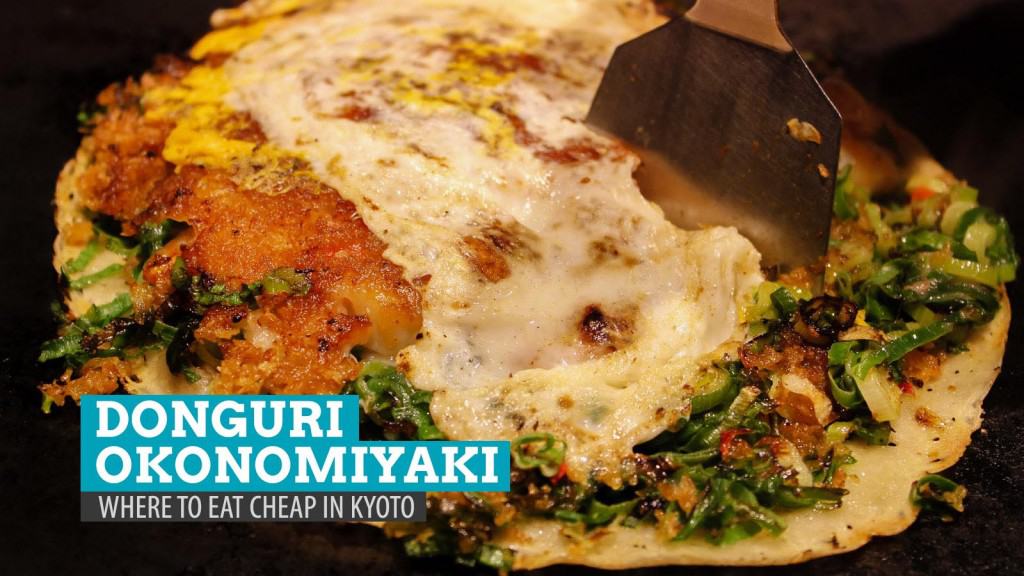2013 • 8 • 21
It was my last night in Japan and I was sure I had more than enough money to carry me through a sit-down dinner (as opposed to the usual convenience store sushi takeouts). That evening I was certain I wanted to try okonomiyaki for the first time. It was a delicacy that I had long wanted to try since my plane landed in Japan, but my unreliable sense of direction could not bring me to an okonomiyaki place in Osaka. Finally in Kyoto, on the way back to the hostel, I spotted an unassuming restaurant tucked along Karasuma Street.
After a minute of waiting, my travel buddy and I were led by a waitress deeper into the restaurant where big tables were arranged neatly. Each table in the area had an iron griddle to keep the food warm. The crowd here was young that night — students and yuppies enjoying great food and greater conversations.
When the waitress realized we were not Japanese, she hurried to one corner and returned with an English menu. The menu was fantastic. Not only did it explain the dishes well, there were also instructions on how to prepare the okonomiyaki Kyoto-style.
Okonomiyaki vs Betayaki vs Negiyaki
Okonomiyaki is a traditional Japanese savory pancake. It’s a portmanteau — okonomi, which means “what you like” because you can add any other ingredient you want; and yaki, which means “grilled” or “cooked.” Although the meat ingredient varies depending on who’s cooking and who’s eating, the base remains the same — wheat flour, eggs, and cabbage. The Kansai Region is said to be the birthplace okonomiyaki, and Osaka and Hiroshima became famous for these veggie pancakes.
The city of Kyoto, on the other hand, is known for two other varieties of okonomiyaki. Betayaki is much thinner but uses the same base ingredients. Negiyaki replaces cabbage with scallions (Japanese bunching onions, known in the vernacular as kujo).
We would love to try all three, but with only two stomachs to accommodate them, we had to give up betayaki. The decision-making, however, did not stop there. Donguri serves several versions of these pancakes. There are beef, pork, seafood, and even vegetarian options. Since we were both okonomiyaki virgins (read: first-timers), we opted with the standard okonomiyaki. We went for the less boring option for our negiyaki — seafood.
When they were served, we were overwhelmed by its size. We didn’t realize that each serving would be big enough for two. The okonomiyaki had a thicker batter. Negiyaki was thinner but more loose. This made it harder to be cut by the spatula. The hot griddle kept “cooking” both pieces as we followed the instructional card on how to season and garnish them. We added sweet and spicy sauces and sprinkles a bit of dried seaweed.
Both were crunchy on the outside and soft on the inside. Both were very filling. Both tasted really, really good. The freshness of the vegetable ingredients stood out, complimented with the teriyaki-reminiscent sauce. The okonomiyaki looked more like pancake and the negiyaki more like thin crust pizza. They may not look alike, but they tasted strikingly similar. Except for the shrimps and clams, I couldn’t even tell the difference.
Maybe it was just me. Maybe I was just drunk.
Sake vs Chu-hi
Well, I wasn’t drunk. But I was drinking in between bites of those pancakes. On my left hand side was a small glass of warm sake. And on my right, a cold mug of red chu-hi.
The drink selection of Donguri is quite limited, which was a welcome ease. Since I had never before had a drop of sake, I was sold as soon as I spotted it on the drink list. But I knew that I had a love-hate relationship with strong drinks, so I had to have a safe back-up. Chu-hi looked irresistible on the menu. Chu-hi comes in a variety of flavors (fresh lime, green tea, etc) but the waitress recommended the red concoction.
As expected, the sake was too strong for me. Yeah, I’m lame like that. But the chu-hi was a winner. It tasted strong, too, to be honest, but it had this fruity taste that disguised its alcohol content. It reminded me of our very own cocktails-in-a-bottle (Tanduay Ice) except it had more kick and flavor, thanks to the port wine in the mixture. Chu-hi is said to have originated in Kyoto, and is the perfect match for okonomiyaki according to locals.
By the end of the night, we were awfully full that we could not even touch the other dish we ordered, Beef and Cabbage. We had to wait it out and made room in our tummy before we finally dug in again, but we were not disappointed either. It was the perfect combination of spicy and sweet, veggie and meat.
Overall, it was the best meal we had in Kyoto. I have to admit, however, that part of the judgment was the freedom from worrying too much about the budget. Donguri is economical, but not compromising the service and the food — perfect for budget travelers who are out to have their own enjoyable authentic Japanese dining experience in Kyoto.
Donguri Okonomiyaki Dining
Karasuma Street, Kyoto
Phone Number: +81 75-353-1777
Website: kyoto-donguri.co.jp
Full menu hereOpening Hours
Mondays to Saturdays: 05:00pm to 03:00am
Sundays and Holidays: 11:30am to 03:00amHow to get to Donguri Okonomiyaki Restaurant Karasuma: From Kyoto Train Station, walk down the road perpendicular to the station. That’s Karasuma Dori. Walk straight and you’ll find it to your left before you reach Shijo Street.
